In SPED 415 INS DSGN II: CURR PROC & IEP, I had the opportunity to do observation hours in at Hermon L. Horne Elementary school for several weeks. While I was there, I had the opportunity to learn from a master Special Education teacher. Through her leadership, I had opportunities to analyze quantitative data that were a part of several students IEP goals as well as plan and organize a lesson for two students who struggle in English classes. I made decisions and solved problems as they pertained to redirecting students behaviors.
During my forty five hours, I wrote several journal entries that detail the academic skills that I saw and performed during my time at Hermon L. Horne. I feel that these opportunities helped me to be successful in my current internships. My experience at Hermon L. Horne will certainly provided me with tools and materials that I will use in my future jobs.
Marysa Conn
Journal Entries
SPED 415
Journal Entry 1
I was in the fifth-grade math classroom. The students worked independently on classwork while the lead teacher and the co-teachers did some small group work. I worked with a student, C, who has ADHD. She had some attention-seeking behaviors. At first, she struggled to begin the task and to attend to it. I had her sit at a separate table where I believed she might focus better than she did at her desk. The table had another student already working there. I did not know that these students struggled to be around each other. I ended up staying at the table with them and encouraged them to focus on their work and not on each other. After a while, I put her back at her desk so that I could continue circling the room to assist students. If I were in the same situation again, I would do the same thing again. I believe I did the best I possibly could given the limited information that I had about the two students that do not get along with each other. As soon as I realized it, I stayed with the students to defuse potential conflict.
Journal Entry 2
Today I worked with four math students that needed extra help working on the order of operations in math. We used PEMDAS as a pneumatic device to remember parenthesis, exponent, multiplication, division, addition, and subtraction. I assisted them with reminding them that it doesn’t matter which order multiplication/division and addition/subtraction come up in the problem. Whichever one comes first on the tier gets completed first.
Additionally, I helped a third-grade girl named Cc who has ADHD. At first, I redirected her to the reading assignment on her laptop. It was a comic book on the online program called RAZ kids. When she finished, the lead teacher instructed us to read a leveled reader book about a pug and a chicken. I guided her along and helped her to sound out the sounds she did not know.
Journal Entry 3
I worked with three groups of kindergarten students to do a part-part whole math activity. The students counted chips and practiced writing the number. Then I asked them to tell me how many of the chips were yellow and how many of the chips were red. Then I would cover up some of the chips and count up to tell me how many were hidden. I differentiated the math. I gave five chips to each student and covered them up. From there, I determined if the students needed more so that the activity was more challenging or less if they needed more assistance. I also helped some students to attend to the task when they became distracted.
Journal Entry 4
I observed in the facts classroom in the morning. The students were finishing up their breakfast. Then, they started their morning circle time as a group. They worked on using a picture to indicate that they need to sit down in their chair. They also used pictures to identify their friends and to identify which students were absent. I observed how the lead teacher handled challenging behaviors and interruptions to her lesson.
Later that day, I worked with three groups of kindergarten students to work on more and less groups. It was used to introduce the concept of subtraction as well when I would use cups to hide some of the bear manipulatives and have them determine how many were under the cup.
Journal Entry 5
I observed three students in a Sonday reading program learning group. The Sonday program is a form of direct instruction. There is a script for the teacher to use to lead the students through several drills broken into timed sections. The students did sound card drills, wrote down the spelling of the sounds that they heard, read the words, and spelled words using echo tap spelling. This program uses choral style of practice to teach phonics. It was interesting to watch the students complete the drills and use the mnemonic devices from the program to sound out words. I also watched the veterans day program that the students put on. I observed two teachers working with a student in the inclusive SPED program during the performance. He struggled to stay in the area with the two teachers that worked with him. I assisted them in preventing his eloping behavior by standing up and using the blocking technique I learned in the preschool SPED class that I worked at in the past.
Reflection
During my experience at Herman L Horn Elementary School, I learned that each individual with a disability has different home life situations, needs, and personalities. For example, no two cases of ADHD are the same. Some students need extra time to complete assignments, or to have quizzes read to them. Sometimes a student’s disability impacts the student around them. During those moments, it is important for teachers to redirect the negative behavior, address it, or move the student that is being disruptive to a different place in the classroom.
I learned that lesson planning is useful for effective time management during a lesson. It is also important for leading instruction and ensuring that all of the content is covered. Additionally, it helps to list out the materials that you will need for the lesson. That way, the teacher does not have to take away from instruction by getting up during the lesson to get things. I learned that assessments drive instruction by showing teachers what they need to reteach in the next lesson or if any problems need to be rewritten for clarity because a majority of the class missed them.
The students with disabilities learned that I care and that I am determined to assist their learning journey any way I can. Sometimes that means I differentiate a lesson and other times that means I offer emotional support. During my time at Herman L Horn, I have read tests to students, sat by them to help them to stay focused, and worked one on one to help them to master the content.
I was able to see the Stem lab that had Osmo tablets that teachers can check out to use with their students. It has different pieces that can be used for teaching reading and math. It is a type of game that has a camera. It is a good learning tool because it incorporates technology. Students are also able to do this activity independently because it self checks.
I have learned a lot about the co teacher relationship as well as what it is like to share a workspace with other teachers. There is one experience in particular that stands out to me. The teacher that I work with volunteers her room to be the make up work room for students to catch up on missed assignments during recess time. One day, she had about 15 students come into her classroom. This was a disruption to the other teachers who share her room because it was noisy during their break time. They expressed this to her, and she ended up having to tell the classroom teachers the number of students that they could send. They communicated with her and she respected their opinion and made the appropriate change.
I learned that sometimes I struggle to redirect students when I am teaching a group lesson. I can redirect them if it is off topic, but if it relates, I sometimes let the students ramble for a short time. I like it when students can relate the lesson to a previous experience that they have had in their life.
Another project that I completed at Hermon L Horne was to create a lesson plan. I was not expected to teach it, but to teach it to two third grade students. I demonstrated an example of product I was looking for by doing the steps with them. I scaffolded the assignment so that the students that struggles to write sentences could focus on writing one instead of two. I taught this lesson in two parts. In the first part, we read the story and brainstormed for the sentences. For the second part, I had the students write the sentences. Then I had them draw and color the animal that they chose to write a fact and ask a question about.
Lesson Plan – Tiny Report
Date: 11/4/2022
Lesson Title: Tiny report
Lesson Author: Marysa Conn
*Based on the book “What’s under the Ocean?” by Melvin and Gilda Berger.
Grade Level
Third grade
CG- other learning disability (ADHD)
G_ – doesn’t not have an IEP
Subject Area: Reading
Time Allotted for Lesson: Express in number of class meetings and/or number of minutes.
Two half hour times
Short Description of Lesson
In this lesson, the students will be introduced to a book titled, “What’s under the Ocean?” by Melvin and Gilda Berger. They will be asked to tap into their prior knowledge of the animals that live in the Ocean before they read the book. After reading the book, they will create a small report on an animal from the book to reinforce the authors purpose for writing the book.
Standards
Standards – (Standards utilized in lesson plan)
3.6 a – Identify the author’s purpose. (Focus Skill)
3.5 g Ask and answer questions about what is read.
Focus
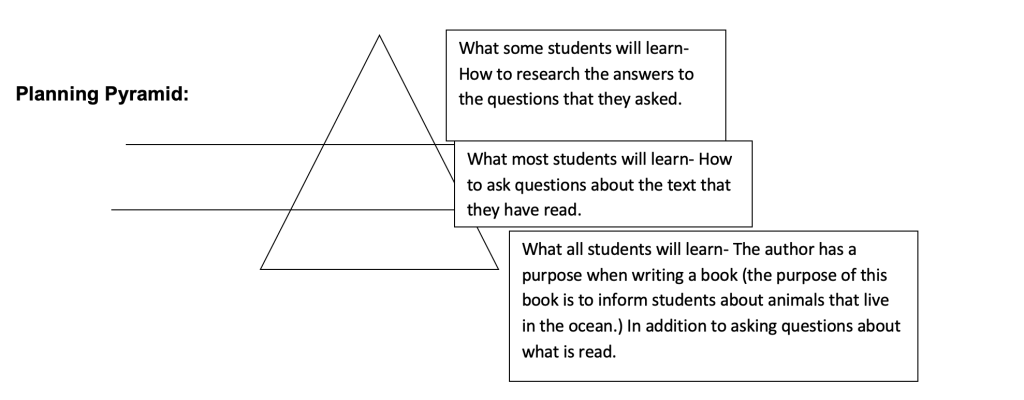
Stages of Learning:
- Acquisition The student will find one fact about one animal.
- Proficiency The student will write one sentence based on the fact that they found. They will also be able to ask a question about an animal where the answer cannot be found in the book.
- Maintenance The student will be able to identify facts and ask questions.
- Generalization This skill is important in other classes where research will be conducted. It will be important for the students to identify facts and ask question for reports.
- Application. The student can ask questions and find the answers to them.
Essential Questions
What was the authors purpose for writing “What’s under the Ocean?”
What else would you like to learn about ocean animals that was not in the book?
Instructional Objectives
The student will write two sentences. One will be a fact about an animal from the book. The other will be a question based on the animal that they chose. They will write at least one question for 50% accuracy.
Lesson Set Procedures
Rationale
This lesson is important for students to know because it extents their knowledge on the book that they are reading while teaching them how to do research. They will use this skill as they carry on in their academic career.
a. Anticipatory set:
I will explain that we are going to be starting a new book about the ocean. I will start with figuring out what the students currently know about the ocean. The student will be given a piece of paper. They will have two minutes to write down as many things that they can think of that are under the Ocean. Then, I will have them go through the book and pick one of the animals that they would like to do the project on.
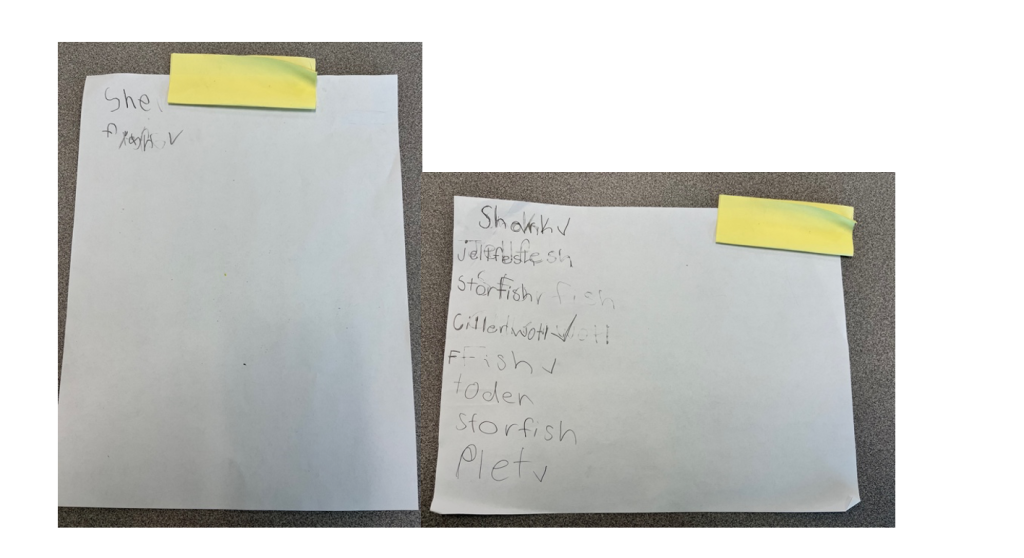
These are the brainstorms on animals that the students know The check marks indicate the ocean animals that the students brainstormed and also found in the book.
b. Input/Modeling:
After reading the story, we will use the text features to create a small poster about animals in the ocean using the text features in the book. “First, we will choose an ocean animal that we want to do our tiny report on. Using the information that we have just read in the book, we will come up with two sentences on the animal. The first sentence will be a fact from the text. The second will be a question about something that we would like to know more about from the text. Then, we can draw a picture of the animal to include in our tiny report. Next, we can color it”
c. Guided practice:
I will start an example paper that I created (of an animal that the students have not chosen) for the students on the board and demonstrate how to write at least two sentences about the animal chosen. I will show them how to write down a fact from the book without plagiarizing (and explain what that means). I will also brainstorm with them about the question phrases (who, what, when, where, how?) sentence prompts that we could use to ask a question.
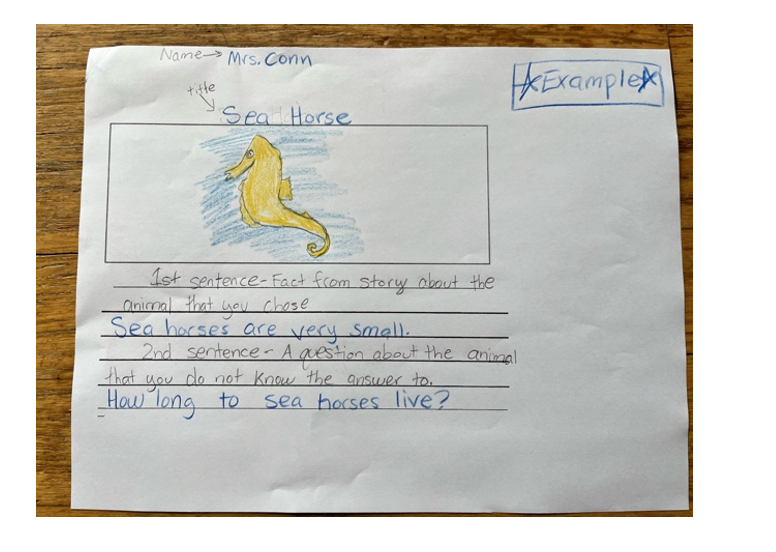
d. Independent practice:
The students will be given time to work on this project individually while I observe them. The students are expected for work on the project individually, it isnt a group project I will be there to provide feedback in situations regarding grammar, how to use the information in the book to compose an original sentence and create a question that they can later research based on the information that they are given if they finish early.
Lesson Closure
To summarize the lesson, I will let students know that they will be using these same strategies to do research in the future in other classes like science and history.
Reflective question
What parts of a non-fiction text can you use when you are researching a question?
What is a skill that you used during this activity that you could use again?
Why did the author write this book (authors purpose)?
Assessment/Evaluation
- · Evaluation: The students will be given a short verbal three question quiz to access their knowledge of the topic based on the reflection quiz.
(The following rubric is set up for elementary age students. The language is put into terms that they can understand. )
| Required elements | Best work possible (3 points) | O.K. work (2 points) | Not the best job (1 point) | Uh oh.. |
| One sentence that is a fact. | The student wrote a sentence with a fact from the story that is not the same sentence that the author wrote with correct punctuation (.,!?) | The student wrote a sentence from the story that was different than the sentence that the author wrote but had either incorrect punctuation (.,!?) | The student copied the sentence directly from the book (plagiarized) and had incorrect or did not have any punctuation (.,!?) | The student did not write a sentence |
| A question that the author does not answer in the book | The student wrote an original question | A student wrote a question that was from the book but it was not a complete sentence. | The student either did not write a sentence or copied it from the book. | The student did not write the sentence |
| The student had a title at the top of there project that is found from the | The student correctly spelled their animal at the top of the page. | The student incorrectly spelled the name of their animal at the top of the page. | The student put the name of their animal, but not at the top. | The student did not put the name of their animal on the paper at all. |
| The student drew and colored a picture | The student drew a picture based on the animal that they chose form the book | The student drew the picture but did not color it. | The student drew an animal not related to the project | The student did not draw a picture. |
Plan for Feedback: I will meet with the students individually for a few minutes to reflect on their understanding of the authors purpose verbally.
Student Products
The students will write two sentences on the animal that they chose from the book. One will be a fact that the author wrote about. The other will be a question to extend what they have learned. They will create a tiny report paper with a picture of the animal and the two sentences using the provided template.
Supplemental Activities: Extension and Remediation
Students can extend the activity by doing research on trusted online sites to find the answer to the question that they asked. They can use the website, “Kidsearch” to research the answer to the question that they wrote. This extension helps students to also focus on what plagiarism is, and how to avoid it by quoting the source that they find the information from.
For remediation, students can work with me individually to refresh their memory on the definition of the text terms. I will reteach the directions and scaffold them through the activity individually by first helping them narrow down their choice of animals from the book. They we will work together to write a sentence based on a fact from the book.
Adaptations for Diverse Special Learners
Learners with mild disabilities will be given extra time and more depending on the type of disability that they have. They can also work with a peer Tudor to help them to work on the project.
- How will you address cultural/linguistic aspects of instruction?
- ESL students can use their English to the language that they speak dictionaries to incorporate the student’s culture by perhaps filling the information from the story that they do not know and having them connect it
- Modifications/Adaptations for Students Who Are Gifted:
Gifted learners will be asked to go on to the kid search and find the answer to the question that they ask. They will conduct the research in small groups and present what they found at the beginning of the next class period.
Differentiated Instruction:
I have differentiated the lesson plan by interest. Each student is going to have a different product because they are able to choose which type of ocean animal from the book that they want to do their tiny report on. They have both “mandatory and optional components” in this interest differentiated lesson plan (Helping all learners, n.d). It is mandatory that the students complete two sentences, but they have full control on what they choose. They all have the same goal, but how they reach the learning target is different (Helping all learners, n.d).
Personal Growth
Reflection(s):
The students were chatting during my group and I had to redirect them. My lead teacher told me that I may want to limit the amount of stories that I let the students tell during the lesson time because it takes away from the short lesson time that we are provided. Additionally, I would have had the students correct their misspellings in the mini lesson by adding time to the assignment. Without correcting the spelling in the assignment, it looks incomplete.
Resources
Materials and Additional Resources:
List all materials (textbooks, maps, crayons, scissors, student whiteboards, research guides, etc.) technology resources (computers, printer, scanner, internet connection, cameras, projectors, etc.) and web addresses that are needed for this lesson. If you are using copyrighted materials, you must include author, date, and publisher.
Paper for brainstorming.
Colored pencils
Pencils
The book “What’s under the Ocean?” by Melvin and Gilda Berger
Provided sheet
Scratch sheet of paper to show prior knowledge
Web and Attachment Resources and References:
Kidsearch
Helping all learners: Interest. Helping All Learners: Interest | EL Education. (n.d.). Retrieved November 29, 2022, from https://eleducation.org/resources/helping-all-learners-interest
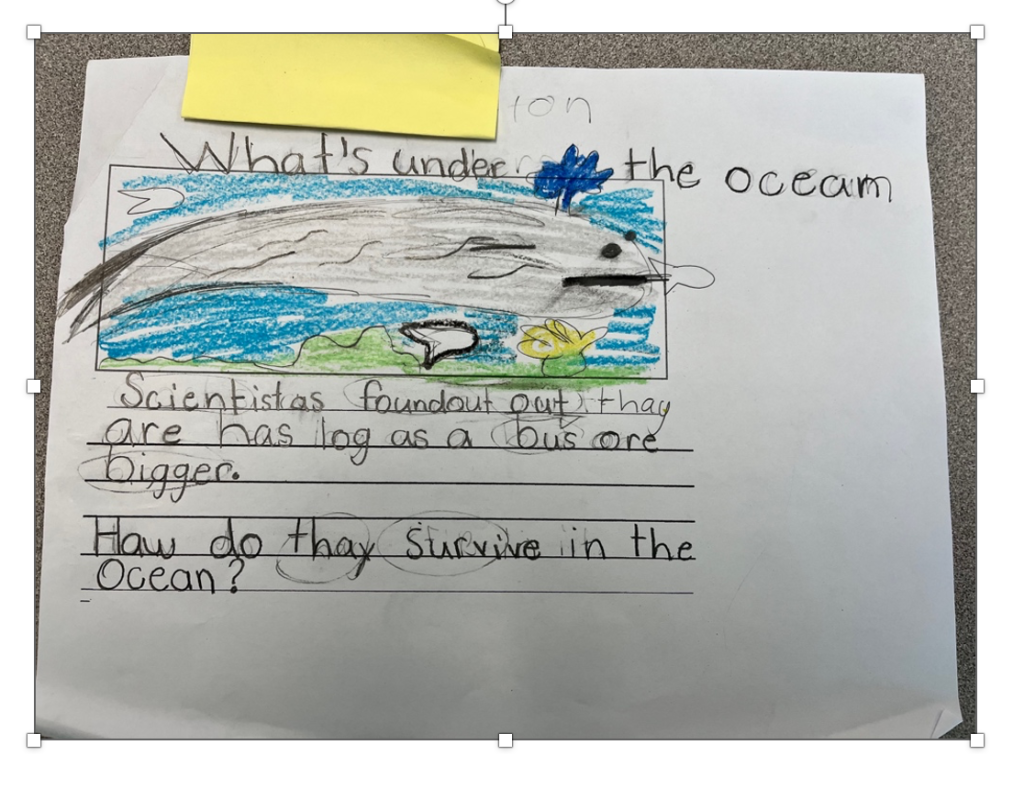
CG’s product
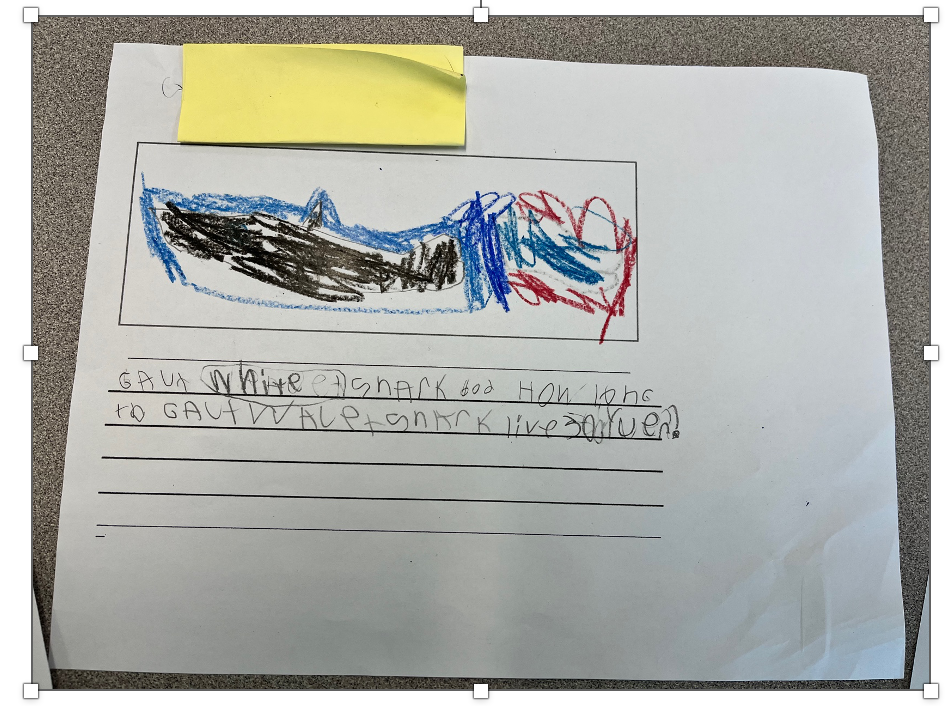
G’s final product